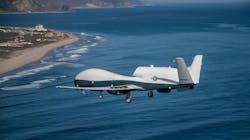Northrop Grumman to build four MQ-4C maritime patrol unmanned aircraft and sensors for Navy and Australia
PATUXENT RIVER NAS, Md. – U.S. Navy unmanned aerial systems experts are asking Northrop Grumman Corp. to build four MQ-4C maritime-patrol unmanned aerial vehicles (UAVs) -- three for the Navy and one for Australia -- under terms of a $542.9 million order announced on 31 Oct.
Officials of the Naval Air Systems Command at Patuxent River Naval Air Station, Md., are asking the Northrop Grumman Aeronautics Systems segment in San Diego to provide the four MQ-4C Triton unmanned aircraft, as well as one main operating base for the Navy and related support.
The MQ-4C Triton is a maritime patrol version of the Northrop Grumman RQ-4 Global Hawk long-range reconnaissance UAV. The Triton provides real-time intelligence, surveillance, and reconnaissance missions (ISR) over vast ocean and coastal regions.
The unmanned aircraft is designed to perform continuous maritime surveillance, conduct search and rescue missions, and to complement the Boeing P-8 Poseidon crewed maritime patrol aircraft.
The Triton can be fitted with AN/DAS-3 Multispectral Targeting System (MTS) sensors from Raytheon Technologies Corp. (RTX). The UAV's suite of sensors can detect and classify different types of ships automatically.
The Triton also has an air-to-air radar system for safety and separation, as well as the Northrop Grumman Multi-Function Active Sensor (MFAS) maritime search radar that provides the UAV with a 360-degree view of a large geographic area while providing all-weather coverage for detecting, classifying, tracking, and identifying points of interest.
The Triton's Integrated Functional Capability (IFC) 4.0 version offers signals intelligence (SIGINT) capability to match that of the Navy's EP-3 manned SIGINT aircraft, which the IFC 4.0 version of the Triton is replacing. The IFC-4 upgrade includes the Minotaur mission system used on the EP-3E.
The Triton program is installing a SIGINT sensor payload with components from Boeing Argon ST in Fairfax, Va., and Sierra Nevada Corp. in Sparks, Nev.
Later upgrades of the IFC 4.0 Triton are expected to involve artificial intelligence (AI) and machine learning; wideband tactical targeting network technology, enhanced radar identification modes; protected satellite communications; M-Code satellite navigation; and counter-electronic attack.
As the IFC-4 configuration is deployed, experts will modify the UAV's mission control centers with special compartmented intelligence facilities to protect sensitive intelligence gathering and dissemination.
On this order, Northrop Grumman will do the work in San Diego, Palmdale, and San Clemente, Calif.; Red Oak, Texas; Linthicum, Md.; Grand Rapids, Mich.; Bridgeport, W.Va.; Indianapolis; Rolling Meadows, Ill; Moss Point, Miss; Chantilly, Va.; Longueil, Quebec; and other locations, and should be finished by January 2028.
For more information contact Northrop Grumman Aeronautics Systems online at https://www.northropgrumman.com/who-we-are/business-sectors/aeronautics-systems, or Naval Air Systems Command at www.navair.navy.mil.
